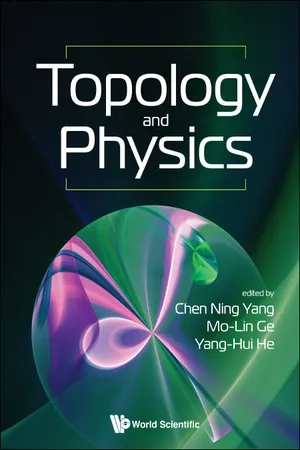
- 232 pages
- English
- ePUB (mobile friendly)
- Available on iOS & Android
Topology and Physics
About this book
Since its birth in Poincaré's seminal 1894 'Analysis Situs', topology has become a cornerstone of mathematics. As with all beautiful mathematical concepts, topology inevitably — resonating with that Wignerian principle of the effectiveness of mathematics in the natural sciences — finds its prominent role in physics. From Chern–Simons theory to topological quantum field theory, from knot invariants to Calabi–Yau compactification in string theory, from spacetime topology in cosmology to the recent Nobel Prize winning work on topological insulators, the interactions between topology and physics have been a triumph over the past few decades.
In this eponymous volume, we are honoured to have contributions from an assembly of grand masters of the field, guiding us with their world-renowned expertise on the subject of the interplay between 'Topology' and 'Physics'. Beginning with a preface by Chen Ning Yang on his recollections of the early days, we proceed to a novel view of nuclei from the perspective of complex geometry by Sir Michael Atiyah and Nick Manton, followed by an entrée toward recent developments in two-dimensional gravity and intersection theory on the moduli space of Riemann surfaces by Robbert Dijkgraaf and Edward Witten; a study of Majorana fermions and relations to the Braid group by Louis H Kauffman; a pioneering investigation on arithmetic gauge theory by Minhyong Kim; an anecdote-enriched review of singularity theorems in black-hole physics by Sir Roger Penrose; an adventure beyond anyons by Zhenghan Wang; an aperçu on topological insulators from first-principle calculations by Haijun Zhang and Shou-Cheng Zhang; finishing with synopsis on quantum information theory as one of the four revolutions in physics and the second quantum revolution by Xiao-Gang Wen. We hope that this book will serve to inspire the research community.
Contents:
- Preface — Early Examples of Topological Concepts in Physics (C N Yang)
- Complex Geometry of Nuclei and Atoms (M F Atiyah and N S Manton)
- Developments in Topological Gravity (Robbert Dijkgraaf and Edward Witten)
- Majorana Fermions and Representations of the Braid Group (Louis H Kauffman)
- Arithmetic Gauge Theory: A Brief Introduction (Minhyong Kim)
- Singularity Theorems (Roger Penrose)
- Beyond Anyons (Zhenghan Wang)
- Four Revolutions in Physics and the Second Quantum Revolution — A Unification of Force and Matter by Quantum Information (Xiao-Gang Wen)
- Topological Insulators from the Perspective of First-principles Calculations (Haijun Zhang and Shou-Cheng Zhang)
- Appendix — SO₄ symmetry in a Hubbard Model (C N Yang and Shou-Cheng Zhang)
Readership: Senior undergraduate student; graduate students; researchers.Topology;Physics;Chern Class;Differential Geometry;Atoms;Nuclei;Algebraic Surface;4-Manifolds;Topological Gravity;Modulli Space;Riemann Surfaces;Kdv;Virasoro;Knots;Links;Braid Group;Fermion;Quantum Computing;Arithemtic Geometry;Gauge Theory;Anyon Systems;Modular Functors;Group Symmetry;Topological Phase;Quantum Revolution;Quantum Information;General Relativity;Yang–Mills;Topological Insulators;First-Principle Calculations;Spin-Orbit Coupling;Surface States0 Key Features:
- World-renowned mathematicians and physicists are the Chapter contributors
- It provides the latest review of the interplay between "Topology" and "Physics"
- Readers can appreciate the beauty of mathematics and physics within one single book
Frequently asked questions
- Essential is ideal for learners and professionals who enjoy exploring a wide range of subjects. Access the Essential Library with 800,000+ trusted titles and best-sellers across business, personal growth, and the humanities. Includes unlimited reading time and Standard Read Aloud voice.
- Complete: Perfect for advanced learners and researchers needing full, unrestricted access. Unlock 1.4M+ books across hundreds of subjects, including academic and specialized titles. The Complete Plan also includes advanced features like Premium Read Aloud and Research Assistant.
Please note we cannot support devices running on iOS 13 and Android 7 or earlier. Learn more about using the app.
Information
Chapter 1
Complex geometry of nuclei and atoms∗
James Clerk Maxwell Building,
Peter Guthrie Tait Road, Edinburgh EH9 3FD, UK
[email protected]
University of Cambridge,
Wilberforce Road, Cambridge CB3 0WA, UK
[email protected]
1.Introduction








Table of contents
- Cover
- Halftitle
- Title
- Copyright
- Preface
- Contents
- 1. Complex geometry of nuclei and atoms
- 2. Developments in topological gravity
- 3. Majorana Fermions and representations of the braid group
- 4. Arithmetic gauge theory: A brief introduction
- 5. Singularity theorems
- 6. Beyond anyons
- 7. Four revolutions in physics and the second quantum revolution — A unification of force and matter by quantum information
- 8. Topological insulators from the perspective of first-principles calculations
- Appendix — SO4 symmetry in a Hubbard model